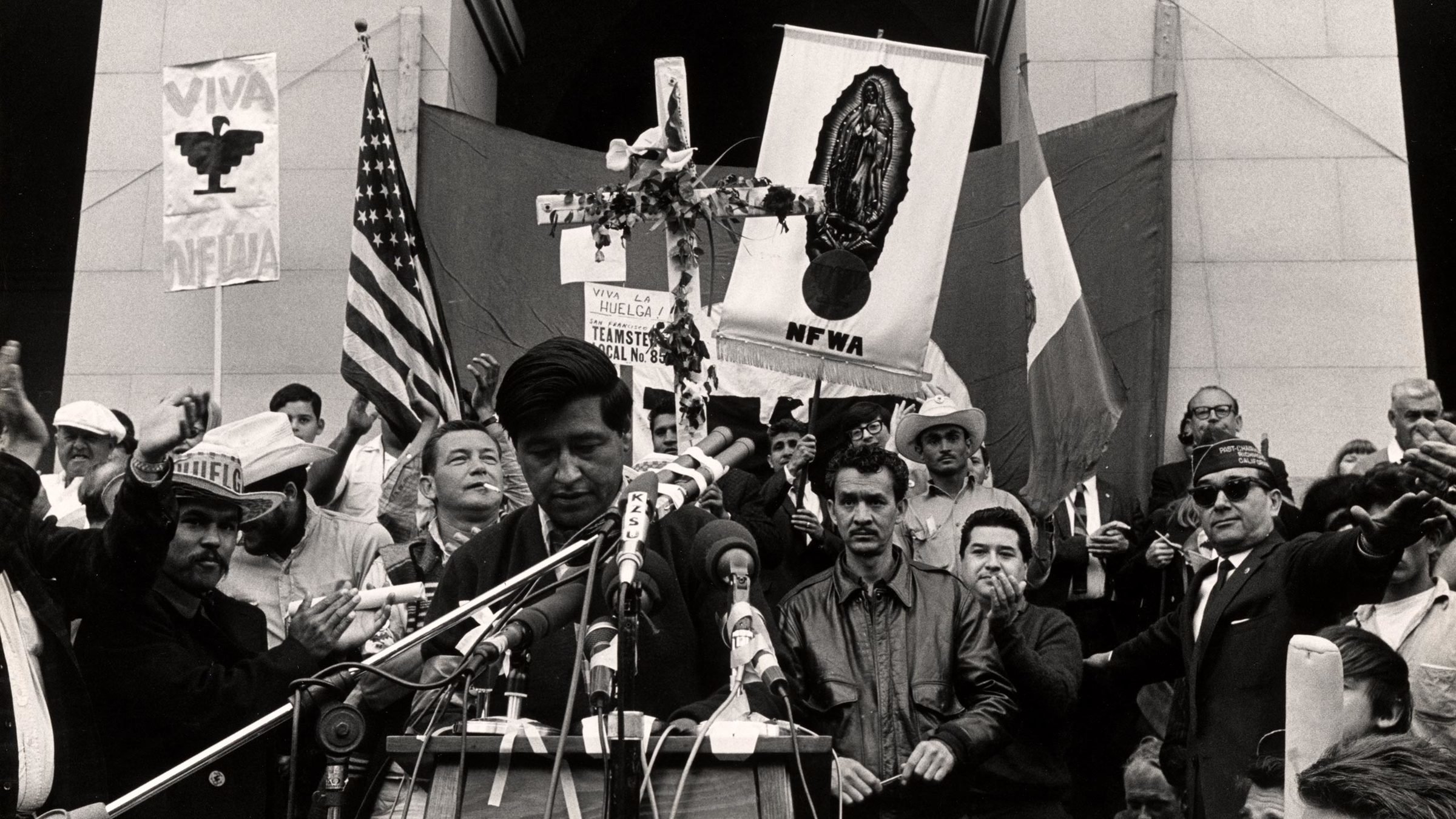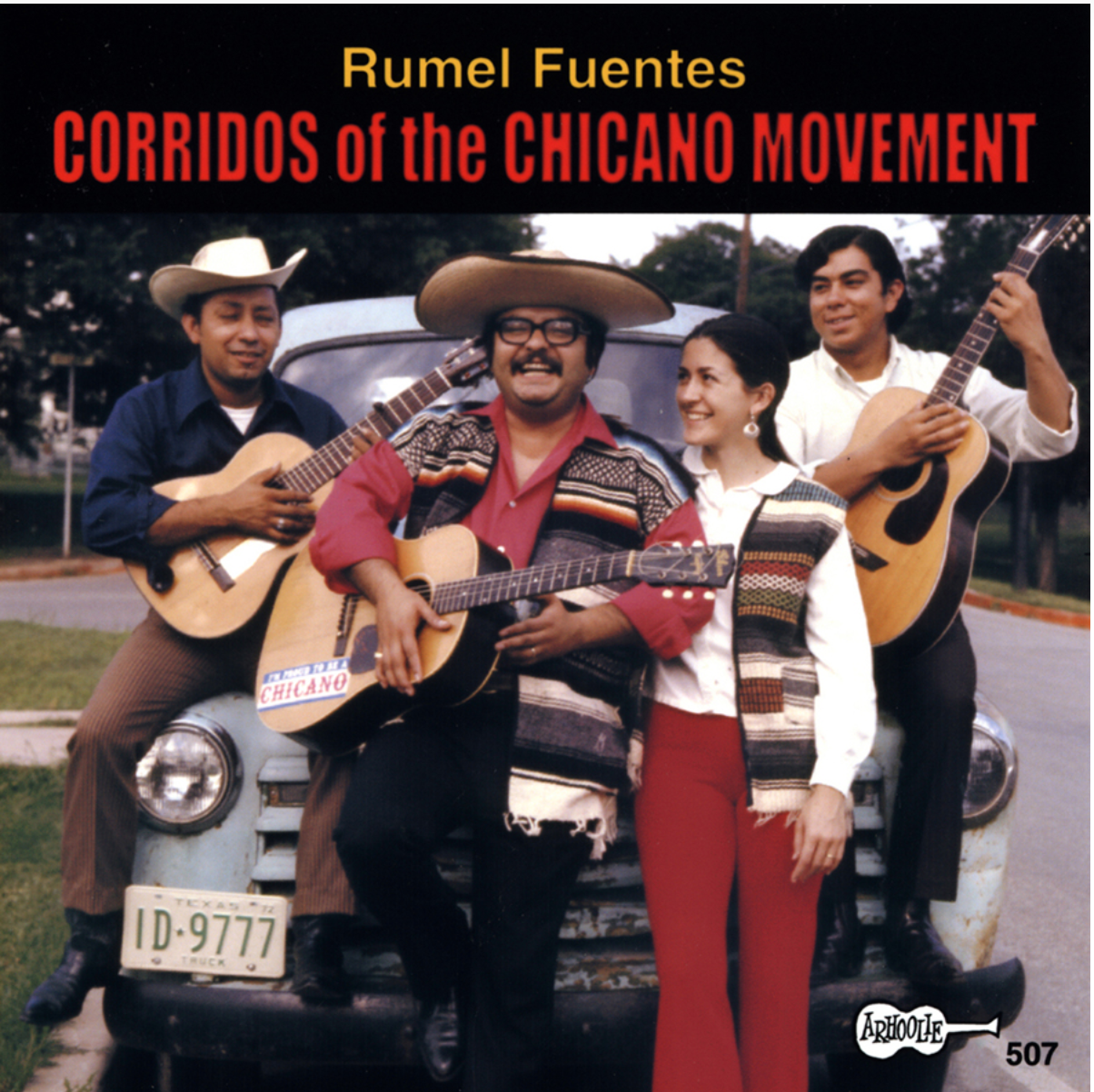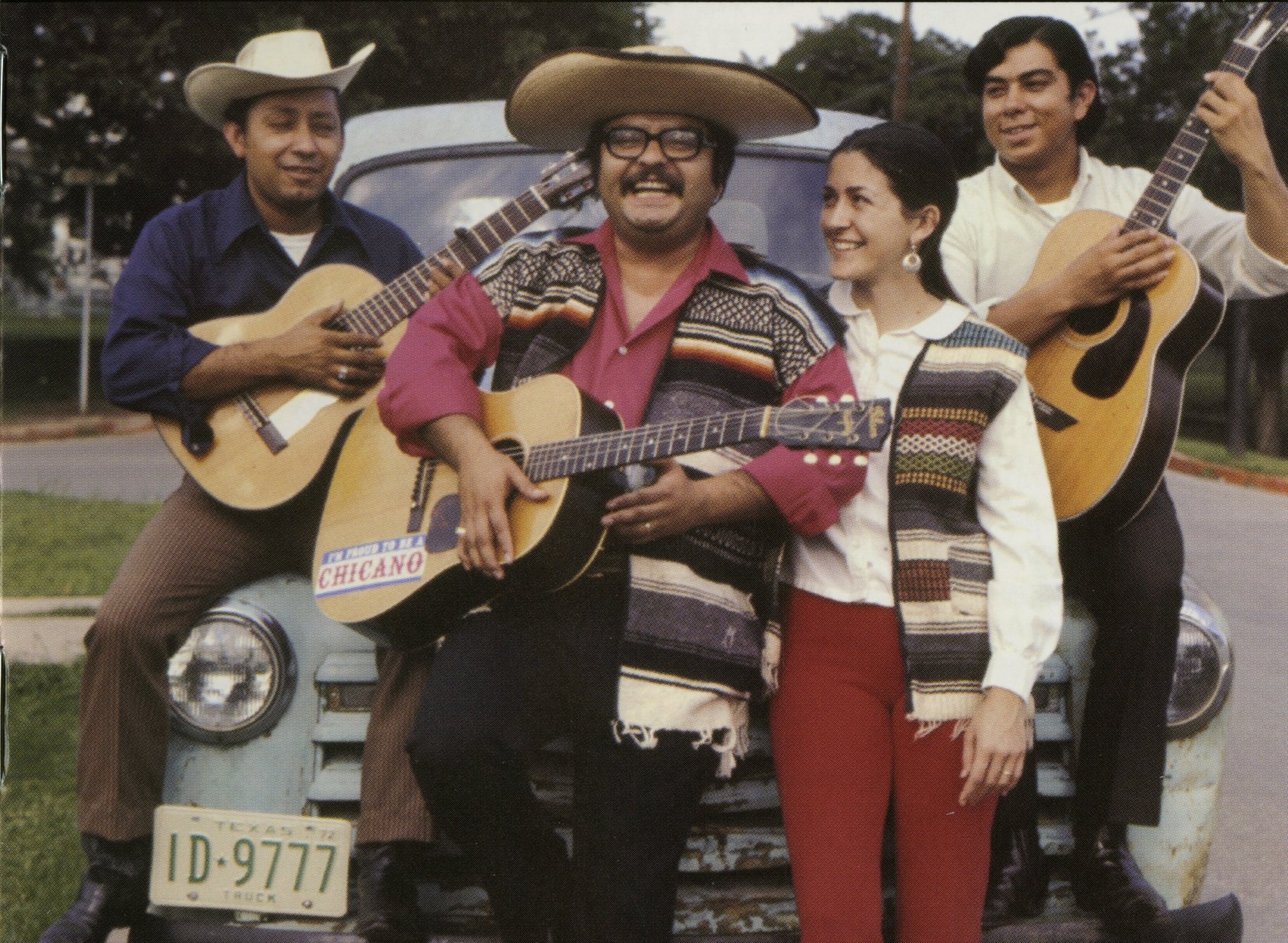Music of the Chicano Movement
Lesson Hub 3:
Corridos: Music as Storytelling and Historical Record


What are corridos and how were they used during the Chicano movement of the 1960s and 1970s?

Mexican corridos, cover art by Irwin Rosenhouse. Folkways Records.
The overarching essential question for Lesson 3 is:

HISTORY & CULTURE
MUSIC LISTENING
20+ MIN
20+ MIN
25+ MIN

Corridos:
Music as Storytelling and Historical Record
CREATIVE CONNECTIONS
The Historical and Cultural Context of the Corrido
Path 1


20+ minutes

Corrido albums (cover art), by Wayne Pope, Morgan Dodge, and Josue Rojas. Arhoolie Records.

Attentive Listening: "El corrido de Reies Lopez Tijerina"

Play a 30–45 second clip from this audio recording.
Think about this guiding question:
What is the purpose of this song?
This type of song is called a corrido.


A corrido is essentially a narrative ballad: Its main purpose is to tell a story.
Corridos have been sung in Mexico and along the US-Mexico border for over 150 years.
Most often, corridos are sung in Spanish.
Smithsonian Folkways Recordings is home to an extensive library of corridos.


Attentive Listening: "Corrido de Río Arriba"

Listen to a 30–45 second clip from a different corrido.
Think about the following guiding question:
What are some similarities between these two corridos?
Corridos: Similarities


Some similarities you may have noted are:
- Both songs have guitar accompaniment.
- Both songs are felt in ¾ time.
- Both songs are sung in Spanish.
- Both songs have one harmony part (in addition to the melody).
- Both songs were written during the Chicano movement (late 1960s–early 1970s).

Corridos are based on epic stories!
In many cases, they tell the stories of ordinary men who became heroes because they were viewed as brave, strong, and willing to stand up to oppressors.
Corridos have been written about tragedies, battles, death, and even elections!
Corridos in Context


Ballads & Corridos (1949-1975), album cover art by Josue Rojas. Smithsonian Folkways Recordings.

During the time of the Chicano movement, some composers used corridos as a vehicle to expose injustices they witnessed, and to relay what they felt was the truth about events—as they were actually happening.
Corridos in Context

U.S. Mexican Border. United States Geological Survey, PD (U.S. Code § 105).

An important theme of many corridos has been intercultural conflict (especially conflict on the US-Mexico border).

Lyrical Meaning:
Reies López Tijerina


Both corridos featured in this lesson were written about an influential (and somewhat controversial) historical figure during the time of the Chicano movement (1960s–1970s): Reies López Tijerina.
During this time, Tijerina became well-known for his aggressive attempts to return land grants to descendants of their Spanish colonial and Mexican owners.

José Angel Gutiérrez, Reies López Tijerina, and Rodolfo 'Corky' Gonzalez at the National Convention of the Raza Unida Party, photo by Oscar R. Castillo. Smithsonian American Art Museum.
Lyrical Meaning: We Want our Land Back!


During the late 1960s and into the 1970s, Reies López Tijerina and other Chicano leaders/activists expressed frustration that Mexican Americans had been forced off land they felt was guaranteed to them through the Treaty of Guadalupe Hidalgo (1848).
They were bitter about “being treated as foreigners on land that was once theirs” (Montoya, 2016, p. 17).

Resurrection City-Untitled, by Jill Freedman. National Museum of African American History and Culture.
Integrating Context:
The Tierra Amarilla Courthouse Raid

Tierra o muerte (Land or Death), by Emanuel Martinez. National Museum of American History.

Famously, Tijerina led the Tierra Amarilla Courthouse Raid, an important historical event and Tijerina's most famous attempt to draw attention to land issues.
The Tierra Amarilla Courthouse Raid culminated in a violent standoff between Tijerina and his supporters, and the local police and political figures in Rio Arriba County, New Mexico (1967).

Listening for Meaning




Click to the next two slides to listen to short excerpts from each corrido again.
What are some differences in these perspectives?
Think about this guiding question as you listen:
This time, follow along with the lyrics, which provide two different perspectives on Tijerina’s involvement in the violence that occurred during the Tierra Amarilla Courthouse Raid.

"El corrido de Reies Lopez Tijerina” by Rumel Fuentes

Aquí vivía la gente / La tierra los mantenía / Pero el tiempo les robó / Las tierras que ellos tenían. / Solo queda una cuchilla / llamada Tierra Amarilla.
Iba un hombre muy violento / Las tierras a recobrar / A las cortes más supremas / subió solo a declarar / Solo una barra de fierro / Fue lo que pudo encontrar.
Reies López Tijerina / Como Zapata, buscaba / Que de esta tierra robada / Hacer lo que Dios mandaba / La justicia se negó / Nunca pudo él lograr nada.
Our people lived here / Provided for by the land / But time stole from them / The lands that they owned. / Only a strip is left / Called Tierra Amarilla (Yellow Land).
A very violent man went / To recover the lands / To the most supreme of courts / He went alone to testify / But only an iron fence / Was he able to find.
Reies López Tijerina / Like Zapata, sought / To make of this stolen land / what God wills / Justice was denied / He didn't succeed.

"Corrido de Río Arriba” by Roberto Martinez

Un grupo de nuestra raza
Muy descontentos bajaron
Y en oficiales de estado
Su venganza, ellos tomaron.
Su jefe les suplicaba
"No debería haber violencia."
Pero no los controlaba
Pues perdieron la paciencia.
Un diputado en el suelo
Se queja con agonía
Con una bala en el pecho
Allá por Tierra Amarilla.
A group of our people
Made their way in great discontent And upon state officials
Took their vengeance.
Their leader begged them
"Violence mustn’t ensue."
But he couldn't control them Because they had lost their patience.
A deputy on the ground
Groans in agony
A bullet lodged in his chest
over there in Tierra Amarilla.
Throughout history, many other important and well-known Mexican and Mexican American leaders (as well as heroes who were affiliated with other social justice movements) have been memorialized through corridos.
Corrido as Memorial



Ballads & Corridos. Album cover art by Josue Rojas. Smithsonian Folkways Recordings.

Corrido Discovery Activity (Optional)

Pancho Villa
Click on the images of the historical figures below to read a synopsis of their stories, and listen to an excerpt from a related corrido.
César Chávez
Martin Luther King Jr.

Francisco “Pancho” Villa

Francisco “Pancho” Villa is one of the most famous symbols of the Mexican Revolution.
Pancho Villa is famous for being an advocate for the poor.
Some have referred to Pancho Villa as Mexico’s “Robin Hood.”

Viva la revolucion, by unknown artist. National Museum of American History.
"Rendición De Pancho Villa," by Lupe Martínez y Pedro Rocha

César Chávez

César Chávez is best-known for his efforts to start a union for farmworkers in the 1960s.
Chávez (along with other activists) organized strikes, boycotts, and marches to bring awareness to the plight of Mexican American farmworkers.
Some of these efforts were successful and resulted in higher wages, better benefits, and more humane working conditions for laborers.
César Chávez, by Manuel Acosta. National Portrait Gallery.

"Corrido de César Chávez," by Los Perros del Pueblo Nuevo

Dr. Martin Luther King Jr.

Martin Luther King Jr. was an important historical figure of the African American civil rights movement.
Martin Luther King Jr. is best-known for using non-violent approaches to advance civil rights.
This corrido was written four days after his assassination in 1968.
Martin Luther King Jr., by Yousuf Karsh. National Portrait Gallery.

"Corrido de Martin Luther King," by Gregorio y María

Learning Checkpoint

-
What types of stories do corridos usually tell?
-
How were corridos used during the Chicano movement of the 1960s and 1970s?
-
Why were corridos written about Reies Lopez Tijerina?
End of Path 1! Where will you go next?






Corridos: Exploring Instrumentation and Musical Elements
Path 2

20+ minutes


Rumel Fuentes, photo by Chris Strachwitz. Arhoolie Records.

Attentive Listening: "El corrido de Reies Lopez Tijerina"
Listen to a short excerpt (30-45 seconds) from a corrido called “El corrido de Reies Lopez Tijerina” (by Rumel Fuentes).
As you listen, think about this guiding question:
Which instruments do you hear?


"El corrido de Reies Lopez Tijerina": Instrumentation


Rumel Fuentes, photo by Chris Strachwitz. Arhoolie Records.
- There is one male voice on this recording (Rumel himself on the melody).
- There is one female voice (harmony). Jo Zettler, Rumel’s wife, sings the harmony (as she did on many of Rumel’s songs).
- Rumel Fuentes (the composer of this corrido) also played classical guitar.
- This recording also includes a requinto guitar (smaller), played on the melodic interludes between verses.

Attentive Listening: Time
Play the same excerpt again, this time with a new guiding question:
What do you notice about the beat/time/meter of this song?


Engaged Listening: Time
The “time” of this song is felt in distinct groups of three (3/4 time):
this is true for most corridos.
Listen again . . .
This time, try to tap, step, or clap the distinct groups of three beats (strong, weak, weak) along with the recording.


Attentive Listening: Form / Structure
Listen again . . .
What do you notice about the form (i.e., structure) of this song?


Attentive Listening: Harmonic Analysis

Listen again . . .
Can you identify the harmonic (chordal) structure?
Raise your hand (or lower it) every time the chord changes.

Considering Transmission
Listen again . . .
How do you think musicians usually learn this type of music?


Oral Traditions

The corrido is primarily an aural/oral tradition.
This means most musicians learn this type of music by ‘ear’ – not by reading written staff notation.
Oral Traditions
Extension Activities (Engaged Listening / Learning by Ear):
- Can you hum (or sing on a neutral syllable) the melody along with the recording? How about the harmony?
- Can you strum I/V chord changes? (Especially if students are learning a chordal instrument, such as ukulele or guitar)
About the Composer: Rumel Fuentes

The corrido you just heard was written and recorded by Mexican American composer/singer, Rumel Fuentes, in Eagle Pass, Texas in the early 1970s.
Eagle Pass is a Texan border town (located along the US-Mexico border).



Attentive Listening: "Corrido de Río Arriba"
Let's listen to an excerpt from another corrido written about the same topic ("Corrido de Rio Arriba" by Roberto Martínez):
In which ways is this musical example different than the last example?

About the Composer: Roberto Martínez

The second corrido you heard was written by another important composer in the southwestern United States during the time of the Chicano movement, Roberto Martínez. It was recorded by his group, Los Reyes de Albuquerque (The Kings of Albuquerque).
Roberto Martínez, photo by Genevieve Russell. Smithsonian Folkways Recordings.


Differences:
Instruments and Music Elements

This recording features a different type of performing ensemble: A mariachi- style group from New Mexico.
This recording has male voices only.
In addition to guitar and 2-part vocal harmonies, this recording features a button accordion.


Roberto Martínez, by Genevieve Russell. Smithsonian Folkways Recordings.

Hohner Corona II Accordion signed by Flaco Jimenez. National Museum of American History.

Optional Assessment Activity

- Listen to Rumel Fuentes’s “El corrido de Reies Lopez Tijerina” again (in its entirety).
- Think about the ways in which music elements and expressive qualities are used, and complete a detailed listening log for this song.

Learning Checkpoint
- How are music elements and expressive qualities often used in corridos (instruments, time, form/structure, harmony)?

End of Path 2! Where will you go next?






Composing Corridos
Path 3

25+ minutes


Eyes of a Teenager Boy, ID 97867105, © Neirfy | Dreamstime.com.

About Corridos

A corrido is a song that tells a story . . . often an epic story that has to do with an important person or event.
Most corridos are composed quickly . . . They are an immediate response to an important event/incident.

Book Clipart. Clipart Library, PD.

Corridos and Stanzas

Each stanza often has either 4 or 6 lines.
A corrido is structured in stanzas (often, 8) –– very much like a poem.
Each line contains 7-10 syllables.
Corrido Stanza Examples


Here is an example of a 4-line stanza from "Corrido de Rio Arriba":
Their leader pleaded with them, “There mustn’t be any violence,” but he could not control them. They just lost all patience.
Here is an example of a 6-line stanza from "El corrido de Reies Lopez Tijerina":
A very violent man set out
to recover the land;
the most supreme of courts
he went alone to testify;
but only an iron fence
was he able to find.

"El corrido de Reies Lopez Tijerina” by Rumel Fuentes

Aquí vivía la gente / La tierra los mantenía / Pero el tiempo les robó / Las tierras que ellos tenían. / Solo queda una cuchilla / llamada Tierra Amarilla.
Iba un hombre muy violento / Las tierras a recobrar / A las cortes más supremas / subió solo a declarar / Solo una barra de fierro / Fue lo que pudo encontrar.
Reies López Tijerina / Como Zapata, buscaba / Que de esta tierra robada / Hacer lo que Dios mandaba / La justicia se negó / Nunca pudo él lograr nada.
Our people lived here / Provided for by the land / But time stole from them / The lands that they owned. / Only a strip is left / Called Tierra Amarilla (Yellow Land).
A very violent man went / To recover the lands / To the most supreme of courts / He went alone to testify / But only an iron fence / Was he able to find.
Reies López Tijerina / Like Zapata, sought / To make of this stolen land / what God wills / Justice was denied / He didn't succeed.

"Corrido de Rio Arriba” by Roberto Martinez

Un grupo de nuestra raza
Muy descontentos bajaron
Y en oficiales de estado
Su venganza, ellos tomaron.
Su jefe les suplicaba
"No debería haber violencia."
Pero no los controlaba
Pues perdieron la paciencia.
Un diputado en el suelo
Se queja con agonía
Con una bala en el pecho
Allá por Tierra Amarilla.
A group of our people
Made their way in great discontent And upon state officials
Took their vengeance.
Their leader begged them
"Violence mustn’t ensue."
But he couldn't control them Because they had lost their patience.
A deputy on the ground
Groans in agony
A bullet lodged in his chest
over there in Tierra Amarilla.

Corrido Rhyming Scheme

Many corridos have an ABCB rhyming scheme.
For example (a stanza from "Corrido de Rio Arriba"):
(A) Un grupo de nuestra raza
(B) Muy descontentos bajaron
(C) Y en oficiales de estado
(B) Su venganza ellos tomaron

Writing a Corrido: 8 Steps

Stanza 1: Ask for permission (Dear audience, I'd like to tell you a little story)
Stanza 2: Introduce the characters
Stanza 3: Present a warning (But wait! There is danger ahead)
Stanza 4: Describe the challenge

Writing a Corrido: 8 Steps

Stanza 5: Build the confrontation
Stanza 6: Unfold the tragedy
Stanza 7: Define the moral
Stanza 8: Bid farwell

Creative Activity: Writing Corridos!

Can you think of a recent event (or person) that has had a direct impact on your life?
Today, you will have an opportunity to write your own lyrics and/or music in the style of a corrido!
Start by considering the following question:
It's Time to Compose!


You can use the provided Corrido Composition Worksheet to compose your song lyrics.
The worksheet has detailed steps for you to follow:
Extension Ideas for Teachers:
-
Ask students to share their lyrics aloud in groups or for the whole class.
-
Create a two-chord backing track and have students speak their corridos in rhythm or compose a simple melody that follows the syllabic structure of their lyrics.
-
If students play a chordal instrument, they can strum along!
-
Organize a corrido concert
-
Listen to some award-winning corridos HERE (written by students!)
Corridos: Common Musical Characteristics


- Guitar accompaniment
- Felt in ¾ time
- Usually sung in Spanish
- Simple harmonic structure
- Songs usually use only 2 or 3 chords (I / V or I / IV /V)
- Often has a melody line and at least one vocal harmony
- Strophic form (AAA)

Mexican corridos, cover art by Irwin Rosenhouse. Folkways Records.

Learning Checkpoint

- What are the most common structural characteristics of a corrido?
End of Path 3 and Lesson Hub 3! Where will you go next?




Choose an Intersecting Path:
Write Your Own Blues Lyrics
Women in the Blues Pathway: Lesson 10, Path 3



UNDER CONSTRUCTION
Lesson Hub 3 Media Credits

Audio courtesy of:
Smithsonian Folkways Recordings
Images courtesy of:
The Arhoolie Foundation
National Museum of African American History and Culture
National Museum of American History
National Portrait Gallery
Smithsonian American Art Museum
Smithsonian Folkways Recordings
TM/© 2021 the Cesar Chavez Foundation. www.chavezfoundation.org

© 2021 Smithsonian Institution. Personal, educational, and non-commercial uses allowed; commercial rights reserved. See Smithsonian terms of use for more information
This Lesson was funded in part by the Smithsonian Youth Access Grants Program with support from the Society for Ethnomusicology and the National Association for Music Education.
For full bibliography and media credits, see Lesson 3 landing page.






